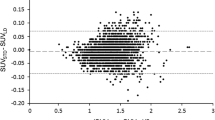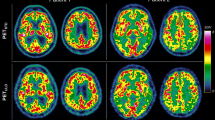Abstract
18F-2-Fluoro-2-deoxyglucose (18F-FDG) can be used to image regional cerebral glucose consumption which allows diagnostic imaging for a number of neurological indications such as dementia, epilepsy and movement disorders. Although not often used in neuro-oncology, it remains the method of choice in the diagnosis and staging of CNS lymphoma. Adhering to guidelines for patient preparation, using the correct imaging acquisition and reconstruction parameters, as well as defining the optimal image display for reporting are all crucial in order to obtain images of diagnostic quality. Furthermore, reporting images in the presence of neurological degenerative diseases can benefit hugely using additional post-processing and quantification of the images. This chapter summarises published guidelines, at the time of writing, on optimal imaging procedures for brain 18F-FDG PET/CT and introduces the reader to some of the more widely available quantification tools and references for optional further reading of developments in the field.
Access this chapter
Tax calculation will be finalised at checkout
Purchases are for personal use only
Similar content being viewed by others
References
Purandare NC, Puranik A, Shah S. Common malignant brain tumors: can 18F-FDG PET/CT aid in differentiation? Nucl Med Commun. 2017;38(12):1109–16.
Demetriades AK, Almeida AC, Bhangoo RS, Barrington SF. Applications of positron emission tomography in neuro-oncology: a clinical approach. Surgeon. 2014;12(3):148–57. https://doi.org/10.1016/j.surge.2013.12.001. Epub 2014 Mar 11
Varrone A, Asenbaum S, Borght TV, Booij J, Nobili F, Nagren K, et al. EANM procedure guidelines for PET brain imaging using [18F]FDG, version 2. Eur J Nucl Med Mol Imaging. 2009;36(12):2103–10.
Waxman AD, Herholz K, Lewis DH, Herscovitch P, Minoshima S, Ichise M, et al. Society of nuclear medicine procedure guideline for FDG PET brain imaging. v1. Society of nuclear medicine molecular imaging. 2009.
Sarikaya I. PET studies in epilepsy. Am J Nucl Med Mol Imaging. 2015;5(5):416–30.
Boellaard R, O’Doherty MJ, Weber WA, Mottaghy FM, Lonsdale MN, Stroobants SG, et al. FDG PET and PET/CT: EANM procedure guidlines for tumour PET imaging. v1. Eur J Nucl Med Mol Imaging. 2010;37(1):181–200.
Leiderman DB, Albert P. The dynamics of metabolic change followingseizures as measured by positron emission tomography with fludeoxyglucose F 18. Arch Neurol. 1994;51(9):932–6.
Administration of Radioactive Substances Advisory Committee. Notes for guidance on the clinical administration of radiopharmaceuticals and use of sealed radioactive sources. UK: Public Health England; March 2018.
Lassmann M, Biassoni L, Monsieurs M, Franzius C, EANM Dosimetry and Paediatrics Committees. The new EANM paediatric dosage card: additional notes with respect to F-18. Eur J Nucl Med Mol Imaging. 2008;35(9):1666–8.
Tong S, Alessio AM, Kinahan PE. Image reconstruction for PET/CT scanners: past achievements and future challenges. Imaging Med. 2010;2(5):529–45.
Dickson JC, O’Meara C, Barnes A. A comparison of CT- and MR-based attenuation correction in neurological PET. Eur J Nucl Med Mol Imaging. 2014;41(6):1176–89.
Spetsieris PG, Ma Y, Dhawan V, Eidelberg D. Differential diagnosis of parkinsonian syndromes using PCA-based functional imaging features. NeuroImage. 2009;45(4):1241–52.
Manda PK, Mahajan R, Dinovc ID. Structural brain atlases: design, rationale, and applications in normal and pathological cohorts. J Alzheimers Dis. 2012;31:169–88.
Brett M, Johnsrude IS, Owen AM. The problem of functional localization in the human brain. Nat Rev Neurosci. 2002;3:243–9.
Mazziotta JC, Toga AW. A probabilistic atlas of the human brain: theory and rationale for its development: the international consortium for brain mapping (ICBM). NeuroImage. 1995;2:89–101.
Minoshima S, Koeppe RA, Frey KA, Kuhl DE. Anatomic standardization: linear scaling and nonlinear warping of functional brain images. J Nucl Med. 1994;35(9):1528–37.
Minoshima S, Kuhl DE, Foster NL, Koeppe RA, Frey KA. A diagnostic approach in alzheimer’s disease using three-dimensional stereotactic surface projections of fluorine-18-FDG PET. J Nucl Med. 1995;36(7):1238–48.
Borghammer P, Aanerud J, Gjedde A. Data-driven intensity normalization of PET group comparison studies is superior to global mean normalization. NeuroImage. 2009;46(4):981–8.
Shen X, Liu H, Hu H, Shi P. The relationship between cerebral glucose metabolism and age: report of a large brain PET data set. PLoS One. 2012;7(12):e51517.
Groeschel S, Vollmer B, King M, Connelly A. Developmental changes in cerebral grey and white matter volume from infancy to adulthood. Int J Dev Neurosci. 2010;28(6):481–9.
Van Bogaert P, Wikler D, Damhaut P, Szliwowski H, Goldman S. Regional changes in glucose metabolism during brain development from the age of 6 years. NeuroImage. 1998;8(1):62–8.
Kinnala A, Suhonen-Polvi H, Aärimaa T, Kero P, Korvenranta H, Ruotsalainen U, et al. Cerebral metabolic rate for glucose during the first six months of life: an FDG positron emission tomography study. Arch Dis Child Fetal Neonatal Ed. 1996;74(3):153–7.
De Blasi B, Barnes A, Galazzo IB, Hua C, Shulkin B, Koepp M, et al. Age-specific 18F-FDG image processing pipelines and analysis are essential for individual mapping of seizure foci in paediatric patients with intractable epilepsy. J Nucl Med. 2018; https://doi.org/10.2967/jnumed.117.203950.
Schenk V. Scenium v.1 and PET, white paper paper. USA: Siemens, Medical Solutions; 2006.
Author information
Authors and Affiliations
Corresponding author
Editor information
Editors and Affiliations
Rights and permissions
Copyright information
© 2019 Springer Nature Switzerland AG
About this chapter
Cite this chapter
Smith, AL., Barnes, A. (2019). 18F-FDG PET/CT: Brain Imaging. In: Fraioli, F. (eds) PET/CT in Brain Disorders. Clinicians’ Guides to Radionuclide Hybrid Imaging(). Springer, Cham. https://doi.org/10.1007/978-3-030-01523-7_4
Download citation
DOI: https://doi.org/10.1007/978-3-030-01523-7_4
Published:
Publisher Name: Springer, Cham
Print ISBN: 978-3-030-01522-0
Online ISBN: 978-3-030-01523-7
eBook Packages: MedicineMedicine (R0)




